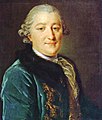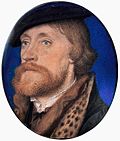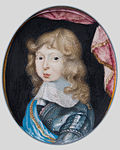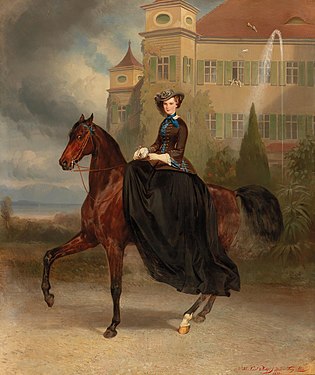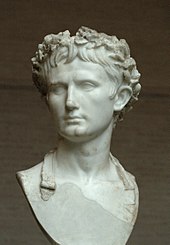portrait


A portrait (from French portrait ) or image is a painting , a photograph , a sculpture or another representation of a person. The portrait usually shows the person's face. In the presentation of several persons is called a double portrait or family portrait or group portrait . Portraying is the making of a portrait. An outdated term for a portrait is likeness .
In a narrower sense, a portrait is an artistic image. A portraying artist is called a portraitist . Some portraitists try to suggest, caricature or exaggerate the essence or personality of the person portrayed in the portrait.
Numerous well-known painters , graphic artists and sculptors have dealt intensively with portraits and thus contributed to the development of a wide variety of representations. The portraiture flourished from about the end of the 15th century until about 1900. Since the 19th century, the portrait photography complements the portrait painting and as a scenic element in the art of film received.
Classification of portraits
The forms of representation are designated according to different aspects: according to the number of people represented and - especially in the case of individual portraits - according to the detail of the figure and the position of the head in relation to the viewer. In addition, portraits are also differentiated according to their function (e.g. portrait of a ruler ) or according to their thematic orientation (e.g. costume portrait ).
According to the number of people
- Single portrait: A single person is shown. This is the most common type of portrait.
- Double portrait: A double portrait shows two people in one picture. An important early example is Jan van Eyck's marriage of Giovanni Arnolfini to Giovanna Cenami (1434; London, National Gallery ). Rubens ' self-portrait with Isabella Brand in the Geißblattlaube (1609, Alte Pinakothek, Munich) is also famous . The painting Lord Mayor of Guaita and Daughter (1817) by Johann Baptist Joseph Bastiné is considered the only "monumental double portrait in the Rhineland at that time ."
- Two single counterparts , mostly of married couples, are not a double portrait, although they belong together and often relate to one another, e.g. B. by the fact that the portrayed of the two pictures turn to each other. Early and famous examples are Piero della Francesca's portraits of Federigo da Montefeltro and his wife Battista Sforza from 1465 (Uffizi, Florence) or Albrecht Dürer's portraits of Hans and Felicitas Tucher from 1499 (Schlossmuseum, Weimar ).
- Group portrait: More than two people are shown. This also includes the family portrait , the representation of the entire family in one work. This subject can already be found by Andrea Mantegna in the decoration of the Camera degli Sposi of the Palazzo Ducale in Mantua , by Jakob van Oost the Elder in a portrait of a Bruges family and, in 1561, the Berchem family by Frans Floris . The family picture was particularly popular in the Biedermeier period . This is illustrated u. a. the works of Johann Baptist Joseph Bastiné and Heinrich Franz Carl Billotte .
Albrecht Dürer , Portrait of Hieronymus Holzschuher, 1526
After the cutout
- Full figure: representation standing or sitting. As sculpture and statue (still image) or statuette called.
- Elbow: including the knees , standing or sitting.
- Hips: upper body up to the crotch
- Half figure: upper body to waist , including the bent arms with the hands.
- Chestpiece: head with a large part of the torso, shoulders and arm sections .
- Shoulder piece or bust ( bust portrait): The shoulders are included and the portrait ends at armpit level.
- Head image: Representation with the neck (neck section) , without any part of the trunk .
For the analogous terms in film, see setting size .
Full figure, standing
Francisco de Goya :
Portrait of Queen Maria Luisa , around 1800Elbow, seated
Auguste Renoir :
Portrait of Tilla Durieux , 1918Hip picture
Anton Graff :
Portrait of Elisa von der Recke , 1794Half-length
Heinrich Christoph Kolbe :
Portrait of a ladyChest piece
Giorgione :
Laura , 1506Shoulder piece ( bust )
Albrecht Dürer :
Portrait of a young woman , around 1506Head picture
Leonardo da Vinci :
Head of Leda ,
study, around 1507/1509
After the head position
Designation for the head posture of the sitter or the perspective :
- Frontal view ( en fac e): The face is directed directly at the viewer . The depiction often appears suggestive and intimate, but also a bit stiff.
- Quarter profile or three-quarter profile / view: (x) The face is slightly rotated from the frontal view. Because of the rounding of the human head, the side of the face facing the viewer is shown in full, the side facing away from the viewer is shown shortened. It is then often in the shade. The figure's gaze is no longer rigid. Is considered to be more lively than frontal, a slight turn of the head is also favored in portrait photography.
- Half profile: The face is shown from the side, the second eye can still be seen. The figure usually looks at the viewer.
- Three-quarter profile or quarter profile / view: (x) A predominance of en profile compared to the half view: the nose often protrudes above the contour, the second eye is half covered or only hinted at. More graceful than a strict profile. If the figure looks at the viewer, the sideways glance can have a profound effect.
- Profile view ( en profile ): The face is shown from the side. Representations in profile based on the model of Roman imperial coins were considered to be the most characterful and dignified representation of humans. Profile pictures as a silhouette were made frequently from the 15th century to the 19th century.
- Lost profile ( profile perdu ): "Three-quarter view from behind", only the contours of the cheekbones can be seen.
- (x) Note: The term quarter / three-quarter is inconsistent in the literature.
(Three-) quarter profile (x) portrait of Count IG Orlow , 1762/65
Half profile
Petrus Christus : Portrait of a Carthusian , 1446(Three-) quarter profile (x) portrait of Giuliano de Medici , around 1478
Profile
Pisanello : Portrait of Lionello d'Este , 1441Lost profile of
Pavel Filonov : self-portrait
Special types of portrait
Self portrait
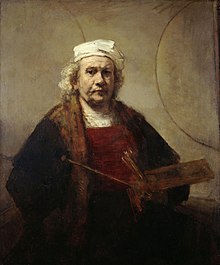
An artist's portrait of himself or his own image is the self-portrait . Self-portraits are among the most famous works by numerous artists. The self-portrait in photography has achieved worldwide distribution. In recent years, self-portraits have become more popular than selfies on social networks .
Ideal portrait
The ideal portrait represented an individual not personally known to the artist as an invented character type (e.g. heads of the legendary Homer ), which should symbolize the essence, but not the realistic figure of the person concerned; this portrait design is already known from Greek times.
A tronie is a portrait painting that, in contrast to a given ideal, was created purely from the personal imagination of the painter, occasionally with the help of a model in order to optimally design position and proportions. These fantasy portraits could be idealizing, but they were not necessarily so.
Stand portrait
At the beginning of the 16th century, when the rule of aristocratic dynasties was viewed as god-given, the “class portrait” also played a key role. It conveys to the viewer the appearance of the sitter, his status in society and family members. These portraits were part of the “representative public” of the court. Presented in ancestral galleries, they testify to the noble origins of the family.
Clothing was used to characterize rank. In the Holy Roman Empire , the dress code drafted in 1497 and approved in 1530 was authoritative, the Reichspolizeiordnung (RPO) for dress and luxury regulations. In this way, the social status can be read from the cloakroom and the jewelry. At the beginning of the 16th century, Emperor Maximilian I used his portrait for propaganda purposes. This type of picture of the “State Portrait” was founded in 1519 by Albrecht Dürer with his paintings Emperor Maximilian I and Jakob Fugger . The dignity of what is depicted is made clear by a reproduction that focuses on the essentials. The physiognomies were also adjusted according to the status.

Tourist portrait
Pompeo Batoni is the inventor of the tourist portrait . He developed this type of portrait for English tourists in Rome who had themselves painted in front of relics of ancient architecture. One of the most famous works of this type is Johann Heinrich Wilhelm Tischbein's Goethe in the Campagna 1786/7. The tourist portrait combines social attributes and souvenir representations. According to AM Kluxen, the English tourist portraits of the 18th century marked the beginning of the end of the professional portrait.The tourist portrait represents a stage in the transition from the professional portrait to the independent society portrait.
Miniatures
One of the most personal forms of portraiture are miniature portraits , which were often commissioned and cherished as a memory of a loved one. Since the early 16th century, artists specialized in these small portraits on paper, parchment , metal and, above all, ivory, which was particularly suitable for depicting the incarnate . The portraits were often set as medallions in expensive golden frames and could be worn on a chain. These miniatures first flourished around 1600 in Elizabethan and Jacobean England, and later also in Empire and Biedermeier , i.e. at the end of the 18th and early 19th centuries.
Hans Holbein the Younger : Thomas Wriothesley , around 1535, vellum laid on cardboard, 28 × 25 mm
Nicholas Hilliard : Portrait of a Woman , 1597, vellum (47 × 39 mm)
Pierre Signac : Charles XI. as a child , around 1662, gouache on parchment, 38 × 33 mm
John Smart : Portrait of a boy , 1770; Watercolor on ivory , 31.8 × 38.1 mm
George Loring Brown : Josuah Richardson Bigelow , 1839; Watercolor on ivory, 69.8 × 63 mm
Equestrian portrait
A rider portrait represents the person on horseback, very often it is a question of portraits of rulers and / or war heroes, i.e. a particularly representative and martial form of the image of a ruler as a war hero. Originally this was mainly cultivated as a sculpture, an example from antiquity is the equestrian statue of Marcus Aurelius in the Capitoline Museums in Rome. As a painting it appears in the 15th century with some frescoes in the cathedral of Florence , which are still painted as imitations of sculptures, u. a. Paolo Uccello's equestrian portrait of Giovanni Acuto (= John Hawkwood) from 1436. In 1547, with his painting Charles V after the battle of Mühlberg ( Prado , Madrid), Titian created the valid prototype of the equestrian portrait in painted form. Other important examples were created by Diego Velázquez (equestrian portraits of Philip IV , the Infante Baltasar Carlos and the Conde Duque de Olivares) or René-Antoine Houasse with the equestrian portrait of Louis XIV (1674, Palace of Versailles ). Women were rarely painted on horseback, exceptions are Velázquez's portrait of Queen Isabella (1635, Prado, Madrid) and some portraits of Empress Elisabeth called 'Sisi', who was a passionate rider and others. a. by Wilhelm Richter , a painter who painted many pictures of horses, rather from a hunting or sporting context.
Conde Duque de Olivares on horseback , oil painting by Diego Velázquez , 1634 (Prado, Madrid)
Queen Isabella on Horseback , oil painting by Diego Velázquez , 1635 (Prado, Madrid)
Equestrian portrait of Louis XIV , oil painting by René-Antoine Houasse , circa 1674 (Versailles Palace)
Franz Adam and Carl Theodor von Piloty : Elisabeth in Bavaria on horseback , 1853
History of the portrait in art and culture
Prehistory: The representation of the human figure is one of the oldest motifs in the history of painting and sculpture. Individual facial features were initially not shown; objects such as spears, crowns and badges of rank were shown as individual and personal attributes . Faces were not shown at all or only schematically in the representations of people from the Stone Age.
Mycenaean culture: The most important death mask is the so-called gold mask of Agamemnon . This presumably represents an idealized portrait of a Mycenaean prince and dates from around 1500 BC. Chr.
Egypt: The first portrait-like sculptures and paintings (tomb art) were created in Egyptian art. The first Egyptian portraits had a religious character, often kings were also portrayed, who were considered earthly representations of the deity. As early as 2600–2160 BC there were pictures with individual portraits and group pictures. Around 1551–1070 BC, personal portraits reached their peak in Egypt , there were model busts. Around 1400 BC The first traditional bust portrait was made: the bust of Nefertiti . Tutankhamun's death mask follows . It is not an image of a realistic physiognomy , but an ideal face typical of the time and culture. Portraits of mummies made during Roman times around 50 AD . They served as grave goods.
Greece: The ideal portrait characterizes Greek art. In ancient Greece, little emphasis was placed on portraits. The images should rather be idealized representations of people ( Homer ).
Hellenism: In Hellenism , the first images of the heads were made on coins, e.g. B. Alexander the Great as Apollo .

Roman art: In Roman houses, death masks of the ancestors hung in the atrium . "Your deeds and achievements were listed under it". The portrait developed from the death masks.
Exact resemblance to portraits was initially not sought in the portrait busts, portraits of the Emperor Augustus, which were created during his entire reign, do not reflect the aging process. For portraits of Roman citizens, the portrait busts of the emperors were decisive, especially in the case of portrait busts of women, the hairstyle of the empresses was imitated. Coin portraits of late Roman emperors, on the other hand, increasingly show the individual features of those portrayed.
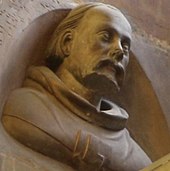
Middle Ages: The first profane portraits of living people are known from the period after antiquity , in Europe from the middle of the 14th century ( late Gothic ). The oldest is the profile picture of King John the Good , which has the portrait of his wife Johanna as a counterpart. The oldest frontal portrait is that of Duke Rudolf IV of Austria . In the Middle Ages up to the 14th century, individual portraits were rather rare. From the 14th century, the need for true-to-nature fidelity developed, and the desire for portraits came closer. Examples are the portrait bust of Peter Parler in St. Vitus Cathedral in Prague and the portraits of Niccolò Albergati (around 1430), Giovanni Arnolfini (around 1435) or Margarete van Eyck (1439) by Jan van Eyck .

Renaissance: In Italy at the beginning of the Renaissance, interest in individual portraits grew not only among the rulers, but also among bankers and merchants. The artist is required to resemble portraits as well as a certain idealization and typification with regard to the dominant ideal of beauty. Artists of this era are: Leonardo da Vinci (including Mona Lisa ), Raffael (including portraits of the Pope of Julius II and Leos X ) or Albrecht Dürer (including self-portraits ).
In Germany and the Netherlands, the special form of “class portrait” or “bourgeois portrait” can be set at the beginning of the 16th century.
17th century: In the Baroque era , the new glaze technique and the loose brushstroke as a stylistic device gave portraits a particular liveliness. Examples are works by Anthony van Dyck , Rembrandt , Frans Hals and Diego Velázquez . In addition, important portrait busts were created, among others by Algardi , Bernini , Coysevox and others. a.
18th century: In the late baroque period, the most influential artists were Hyacinthe Rigaud and Nicolas de Largillière , who cultivated a lively, lively style. In the middle and towards the end of the century, the impulses of courtly painting determined the portraits, in the Rococo (around 1725-1770) with a tendency towards the playful and / or intimate, in Classicism (from around 1770) the representations became stricter and / or simpler. There were also many bourgeois portraits. Notable artists were Rosalba Carriera , Anton Raphael Mengs , Thomas Gainsborough , Élisabeth Vigée-Lebrun .
Modernity: In the art of the 20th century, the painterly portrait was not a central theme, but modern painters such as Picasso or Kokoschka grappled with this theme again and again. Alf Bayrle accompanied the ethnologist Leo Frobenius as an expedition painter. During the trip, portraits were created on the one hand as ethnographic studies and on the other hand as gifts for the locals. Bayrle later processed the portrait theme in his series Heads .
There are significant examples of portrait painting up to the present day from Francis Bacon , Marlene Dumas , Lucian Freud , Willi Sitte and Luc Tuymans .
Portrait photography

Since 1843, the portrait draft was often created using the camera. The idea is said to come from Sir David Brewster . The Scottish painter David Octavius Hill was probably the first to use this method for his monumental group portrait of 470 people in the years 1843–1866. In modern commissioned painting , the oil portrait is carried out on the basis of a photograph - possibly alienated or processed in the computer. There was a new division of artistic work. The portrait is carried out as an oil painting by the artist, while the motif is precisely specified by a photographer or the private client.
Photography, with its soft focus effects, is considered a forerunner of impressionism . The idea of the visit format by the French photographer André Adolphe-Eugène Disdéri contributed to the great popularity of the photographic portrait from around 1860 .
The sitters were initially recorded as if they were on a stage, surrounded by props. Nadar was the first to portray the individual personality.
Features of the portrait
Portraits can have multiple functions; these depend on their context of use. Many ways of use are determined by the memorial aspect of the portrait, so are connected with the memory of an individual person who appears worthy of a portrait due to his social rank, his personality or his special deeds. Examples of this are Egyptian mummy portraits, donor pictures , death masks and portraits with a ceremonial reference such as wedding photos or the enthronement portraits .
In politics, an image of a ruler or a portrait of a head of government is often used as a state symbol , it adorns public buildings, coins, banknotes or even postage stamps and can also be the goal or means of a personality cult .
An important context of use is the social exchange of portraits: portraits on transportable image carriers were exchanged between the royal houses in the early modern period, in the form of diplomatic gifts. In the middle-class letter culture of the Enlightenment, the Romanticism to the modern age and the present, enclosed portraits were used to strengthen family or friendship relationships.
Portraits in the broader sense

In a broader sense, almost every image of a person, even without an artistic character, can be called a portrait, provided that it only makes the person depicted easily recognizable, e.g. B. a mug shot , an ordinary passport photo , a snapshot - or a selfie as a modern form of self-portrait (selfies are often designed to characterize yourself or to convey your own emotional mood).
In addition, there are animal portraits - animal pictures that depict the animal or several animals in a particularly characterful and detailed manner - and landscape portraits.
In a figurative sense, a written description of a person, such as a short biography , is also called a “portrait”. Even with textual descriptions, the term is extended to the detailed representation of various objects to which a character is ascribed, e.g. B. "Portraits" of landscapes, countries, cities, companies, animals, etc.
See also
- Portrait painting
- Image of rulers
- Portrait bust
- Portrait (right) - on copyright
- Right to one's own image - to personal rights
literature
- Sylvia Asmus, Brita Eckert: “My best portraitist…” - portrait photographs and drawings from the holdings of the German Exile Archive 1933–1945. An exhibition by the German Exile Archive 1933–1945 and the German Library . The German Library, Leipzig / Frankfurt am Main / Berlin 2005.
- Hans Belting: Faces. A history of the face, Munich 2013, ISBN 978-3-406-64430-6 .
- Andreas Beyer : The portrait in painting . Hirmer, Munich 2002, ISBN 3-7774-9490-9 .
- Dagmar Hirschfelder: Tronie and Portrait in Dutch Painting of the 17th Century . Berlin 2008, ISBN 978-3-7861-2567-9 .
- Birgit Jooss and Lars Blunck (eds.): The faces of art. Contributions from the conference in the Germanisches Nationalmuseum, Nuremberg 2018
- Andrea M. Kluxen: The end of the professional portrait. The importance of English painting for German portraits 1760–1848. Munich 1989, ISBN 3-7705-2545-0 .
- Andreas Köstler, Ernst Seidl: Portrait and Image. The portrait between intention and reception . Cologne 1998, ISBN 3-412-02698-0 .
- Torsten Krämer: Study of portrait painting from antiquity to the present . Klett Verlag, Stuttgart / Leipzig 2010, ISBN 978-3-12-205121-1 .
- Roland Meyer: Operative Portraits. A pictorial history of identifiability from Lavater to Facebook , Konstanz 2019, ISBN 978-3-8353-9113-0 .
- Miniatures from the Tansey Collection . Tansey collection of miniatures in the Bomann Museum in Celle. 5 volumes. Hirmer, Munich 2000–2013, ISBN 978-3-7774-9021-2 , ISBN 978-3-7774-4335-5 , ISBN 3-7774-2475-7 , ISBN 3-7774-8710-4 , ISBN 3- 7774-9570-0 .
- Rudolf Preimesberger, Hannah Baader, Nicola Suthor (eds.): Portrait. History of the classical picture genres in source texts and comments, Volume 2, Berlin 1999, ISBN 978-3-496-01139-2
- Roman portrait steles in northern Italy : investigations into chronology, typology and iconography / by Hermann Pflug. German Archaeolog. Inst. ISBN 3-8053-0988-0 ; German National Library.
- Daniel Spanke: Portrait - Icon - Art . Fink, Munich 2004, ISBN 3-7705-3908-7 .
- Philipp Zitzlsperger: Gianlorenzo Bernini. The portraits of the pope and rulers . Munich 2002, ISBN 3-7774-9240-X .
Web links
- Portrait types klett.de (PDF)
- Digital portrait index of the early modern period
- Tripota portrait collections: portrait graphics in books from the 16th to 19th centuries in the original and in digital reproduction tripota.uni-trier.de
- Portraits from Goethe's time From the print collection of the Art History Institute of the LMU Munich
- Portrait and portrait in: The large art dictionary by PW Hartmann
Individual evidence
- ↑ See Duden online: portrait and image
- ↑ Duden online: double portrait
- ↑ Duden online: portraying
- ^ Duden online: Portraitist
- ^ Felix Kuetgens : Johann Baptist Joseph Bastiné. In: Aachener Kunstblätter . Booklet XIV. La Ruelle , Aachen 1928, p. 93.
- ↑ Norbert Schneider: Portrait Painting from 1420 to 1670. Cologne 1999, p. 6 .; quoted in Else Lowitzer-Hönig: The early portraits of Oskar Kokoschka. Studies of the individual portraits from 1906 to 1925 - a previously unknown portrait. Diploma thesis University of Vienna, October 2008, p. 17 f. ( pdf , othes.univie.ac.at, p. 11 f.)
-
↑ For example, the Duden gives: "Three-quarter profile, that: view of the head, the face with only a very slight turn to the side." Entry , Duden online - that is, "three quarters of the frontal view";
differently, “three quarters of the profile view”, ie only slightly turned towards the viewer, can be found, according to Klimt, Gustav: Frauenkopf im Dreiviertelprofil , zeno.org; Gustav Klimt: Portrait of a man with a beard in three-quarter profile 1879 , klimt.com; Standing female nude in three-quarter profile from behind by August Wilhelm Dressler , artnet.de
sometimes the -view- and -profile- terms differ from one author , so three-quarter view "three quarters of the face" = quarter profile "one quarter of the profile -Line". So in the above Diploma thesis Lowitzer-Hönig: The early portraits… 2008, p. 18 to Fig. 40 “turned to the left in three-quarter profile” or, p. 76 to Fig. 134 “Head turned slightly to the right in three-quarter view” (Fig. Missing in the pdf), there also the expression three- quarter portrait for strongly averted "from the [...] profile, via the three-quarter or half portrait to the [...] en-face portrait" p. 18, especially p. 35 (pdf p. 41) - ↑ Franziska Gottwald: The Tronie. Pattern - study - masterpiece. The genesis of a genre of painting from the 15th century to Rembrandt. Deutscher Kunstverlag, 2011, ISBN 978-3-422-06930-5 .
- ↑ Andrea M. Kluxen: The end of the state portrait. The importance of English painting for German portraits 1760–1848. Fink, Munich 1989, p. 175.
- ↑ Kluxen, p. 95 f.
- ^ "Bildnis", in: Lexikon der Kunst , Karl Müller Verlag, 1994, p. 175
- ↑ Cleopatra in Art : The Image of a Queen between History and Myth / Patrick Farsen
- ↑ Rudolf Weirich u. a .: Basics of the story. Vol. 1, Frankfurt am Main 1963, p. 120 f.
- ↑ Roman portrait steles in Northern Italy : Studies on the chronology, typology and iconography / by Hermann Pflug. German Archaeolog. Inst.
- ↑ See Duden online: Tierbild und Landschaftsbild
- ↑ There are countless documents to be found on the Internet, for example for a portrait of a landscape or a portrait of a city or a portrait of a company .











